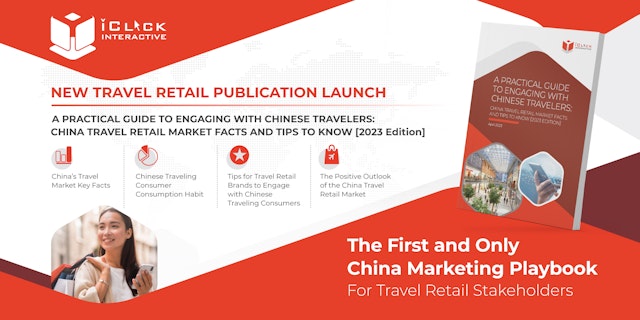China leads in post-pandemic travel retail. Here's how brands can attract Chinese traveling consumers
iClick Interactive’s new report, A Practical Guide to Engaging with Chinese Travelers: China Travel Retail Market Facts and Tips to Know [2023 Edition], highlights Gen Z as growth drivers and explores how brands can incorporate digital technology to provide a seamless shopping experience for consumers.

How can marketers ride the wave of Chinese travel recovery in 2023? / Adobe Stock
As international travel bounces back to pre-pandemic levels, the development of travel retail has progressively gotten back on track, with China leading the way. The Chinese market has shown resilience through a rise in domestic tourism, government duty-free incentives in the Hainan province and the development of travel retail in other cities.
Global martech company iClick Interactive’s latest publication analyzes the impact of the pandemic on travel and highlights the rise of Gen Z travelers interested in experiential consumption, including how outdoor sports and leisure activities such as skiing and camping have taken off in recent years. In particular, Gen Z have become key drivers for travel consumption and played a significant role in promoting “glamping” (glamorous camping) in China.

The report provides an overview of the Chinese travel market and consumer habits using third-party research and public data. It highlights unique characteristics of Chinese consumers, including their preference for mobile payments and the tendency to share shopping experiences online, which travel retail brands should leverage by utilizing peak travel seasons, integrating digital technology, and by providing a seamless shopping experience.
Domestic travelers have adapted to the new normal by opting for shorter, closer and more frequent outdoor trips. While the average travel radius for holidays decreased in 2022, long-distance travel gained popularity as restrictions eased, with Chengdu, Beijing and Shanghai being the top three destinations by plane during the 2023 Chinese New Year. Bangkok, Singapore and Hong Kong were the top three outbound destinations in APAC.
Advertisement
What makes Chinese consumers different from western consumers?
According to iClick’s report, Chinese consumers have a strong tendency to share their shopping experiences online, especially among Gen Z, and place high value on the opinions of those around them, with 62.8% Chinese Gen Z saying they would share products they like online and 53% reporting to have found new brands through friends' posts. Brands that put effort into their social media presence in China, such as WeChat Moments, Xiaohongshu and Douyin, see success.
Another e-commerce trend that is unique in China is ‘community group buying’ (CGB), with young women being the most active participants. CGB allows people to join together on platforms such as WeChat mini-programs or Pinduoduo to buy products in bulk at a discounted price.
Advertisement
The report finds that Chinese tourists also prefer to use mobile payments such as Alipay and WeChat Pay when traveling, with 61% using these compared with just 11% of tourists from other countries. This preference is due to its perceived security, offers of deals and discounts, and better currency exchange rates.
The pandemic has accelerated China’s trend toward online shopping, with e-commerce sales increasing – particularly among those over the age of 30. China Duty Free Group (CDFG) has benefited from this trend, with over 24 million members by 2022 Q3, and has expanded its online presence through apps and WeChat mini-programs.
Tips for travel retail brands to engage with Chinese traveling consumers
1. Chinese Gen Z users put their newfound disposable income toward travel
The increasing importance of China’s Gen Z population in travel consumption, with their average monthly per capita disposable income being ¥4,673 ($682), has led to experiential consumption, with travel, food and nightlife being their main interests. They are also driving the trend of glamping, which has become increasingly popular on social media platforms such as Xiaohongshu.
2. Seizing Chinese peak travel seasons and holiday shopping sprees
The report suggests brands utilize the peak travel seasons and holiday shopping trends in China. Labor Day and National Day Golden Week are the peak leisure travel periods, while the May Day holiday this year is expected to be the peak of outbound travel from China to other countries.
3. Marrying the digital and physical shopping experiences
Due to the pandemic, retail in China has become more digital and duty-free retailers such as CDFG are shifting toward online channels to boost sales. CDFG has developed WeChat mini-programs to cater to the duty-free market in Hainan and these programs have been successful in increasing registered users to 21.9 million in Q1 2022. CDFG’s member platform has also been effective in driving consumption and improving the repurchase rate, with the member sales ratio increasing from 52% to 87%.
4. Incorporating digital technology into retail
The integration of online and physical platforms has contributed to the growth of the travel retail industry, with duty-free operators using technologies such as augmented reality marketing and live streaming to attract customers and increase brand awareness.
Online travel agencies Ctrip, Mafengwo and Fliggy are some of the most popular travel planning and booking apps for Chinese consumers. Unlike traditional platforms, Fliggy, backed by Alibaba, utilizes its vast user data and traffic resources to support travel merchants in digitalization and customer service. It adopts an Online Travel Agencies (OTA) to Online Travel Platform (OTP) model, inviting major airlines and renowned hotel brands to join its platform, giving it an advantage in travel goods pricing.
Suggested newsletters for you
Chinese e-commerce platforms are becoming more diverse and social media is a significant driver of digital advertising spending, projected to grow from $121.5bn in 2021 to exceed $190bn in 2026. ‘Content seeding’, or recommending products on social media, has become an important part of Chinese marketing, with 67.8% of Chinese internet users influenced by seeding content when making purchasing decisions.
5. Short-form videos and social media ads are effective marketing tools
Online advertising has several advantages over traditional media, including broad coverage, a large audience base and long-lasting effects. Short-form videos and social media are popular among advertisers in China, with 962 million short video users as of June 2022. Douyin, Kuaishou, Bilibili, iQIYI, Tencent Video and Youku are popular platforms for advertising. Search ads on Baidu, Sogou, 360 and Google are necessary to capture consumer attention when searching for duty-free products and information. Social media ads are a perfect opportunity to reach consumers as they plan their trips, as many travelers use social media for pre-trip research.
Download the full report to better understand the growth opportunity of the Chinese travel retail and duty-free sector here.
Content created with:

iClick Interactive
iClick Interactive is your digital partner for travel retail. We connect brands and marketers worldwide to the right audience in China and beyond.
Find out more
